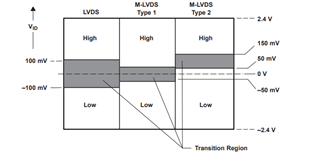The receiver specifications give a combination of min and max threshold voltages, along with a max hysteresis, that I do not know how to interpret.

Does this mean that if I measure the thresholds for my part, and VTH = 80mV and VTL = -80mV, the part is failing the VID(HYS) spec, at 160mV?
I read the thresholds to mean guaranteed ON if above VTH, and guaranteed OFF if below VTL. In this datasheet, does hysteresis just mean the difference between VTH and VTL, or something else?


